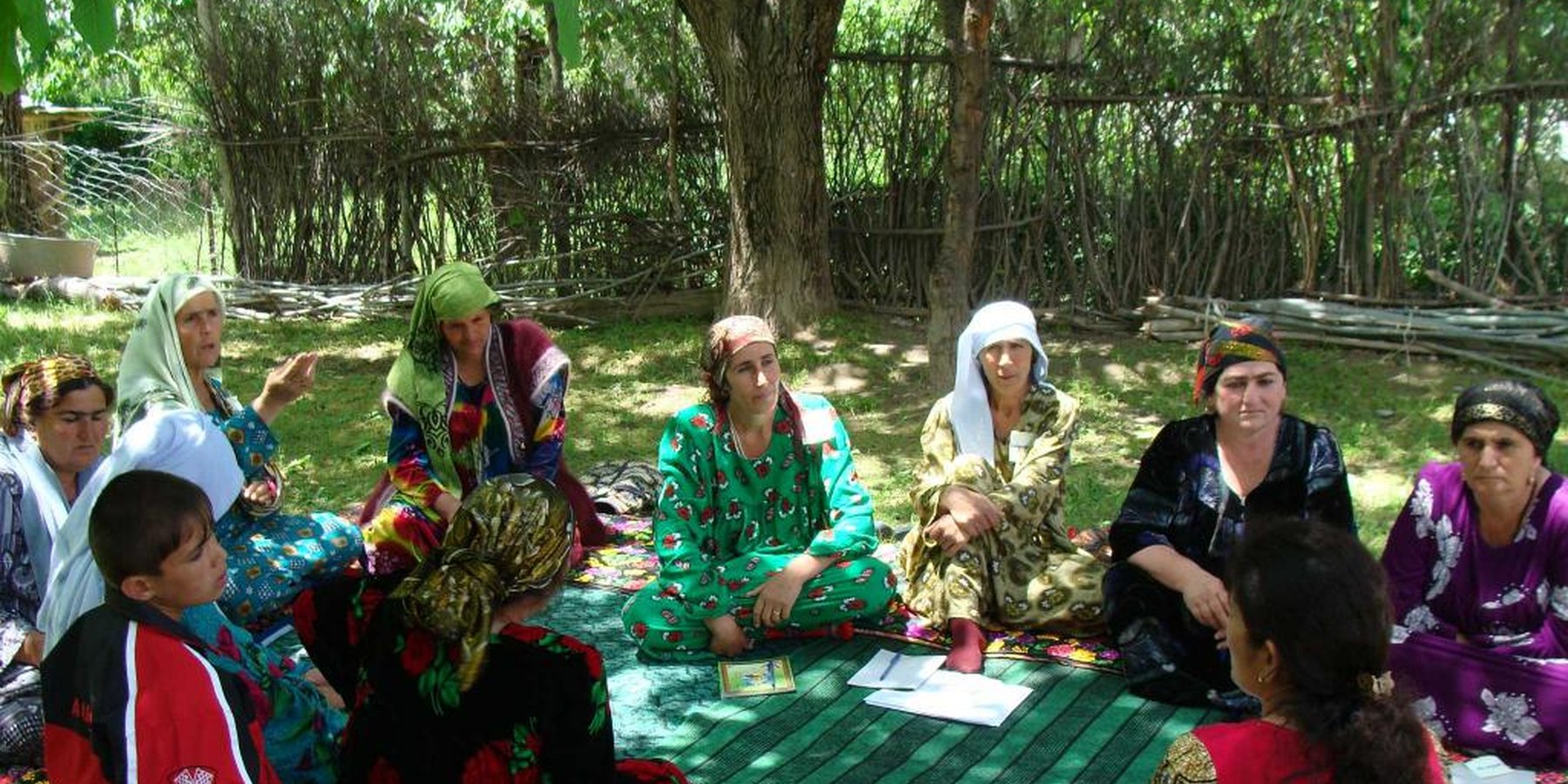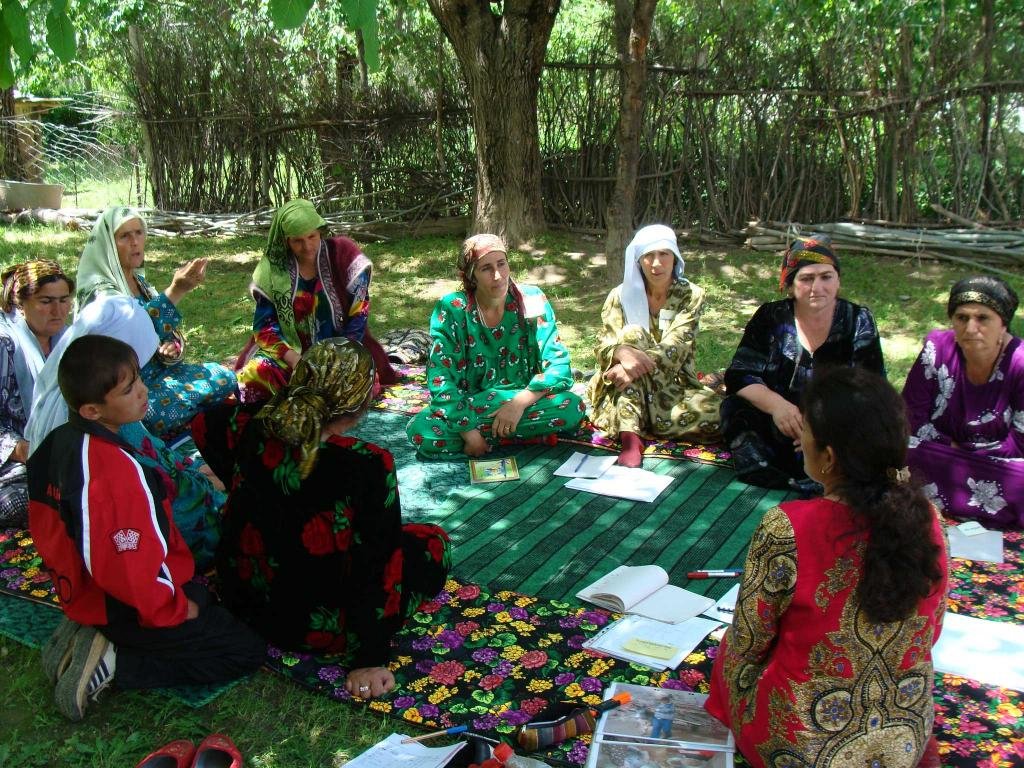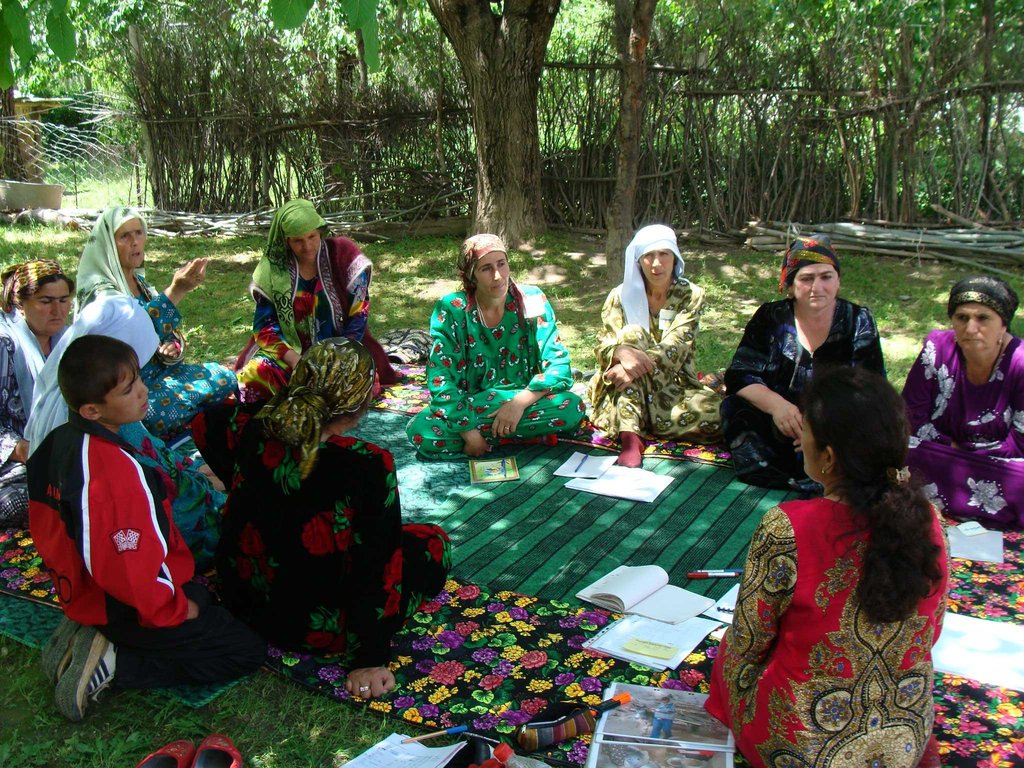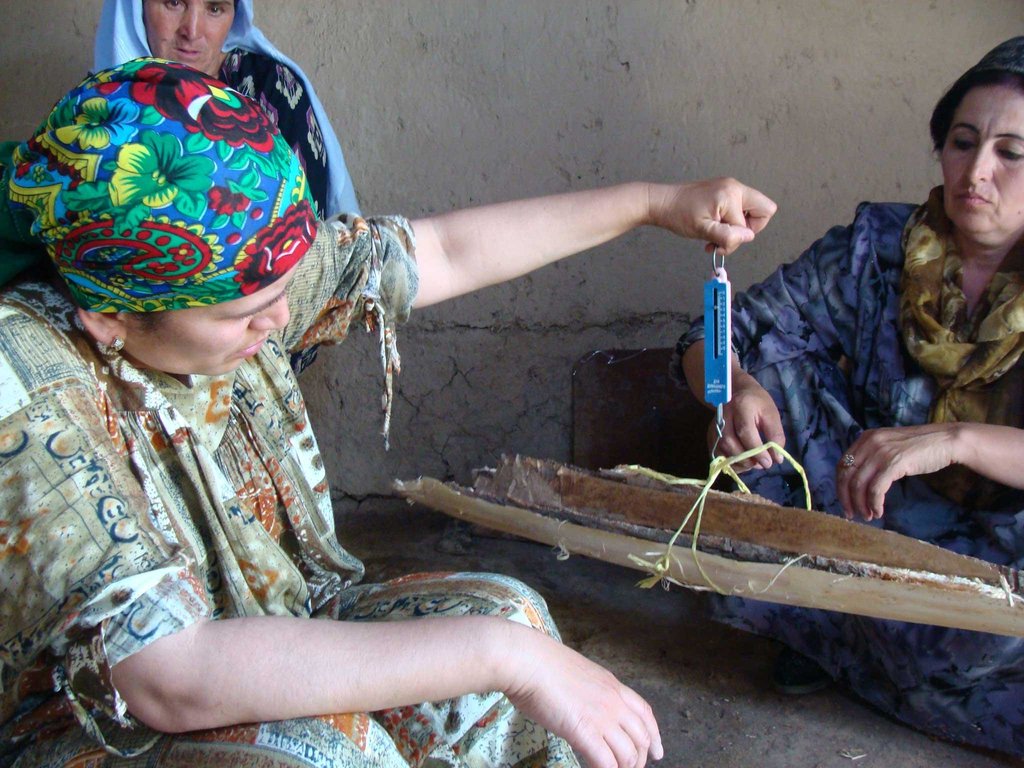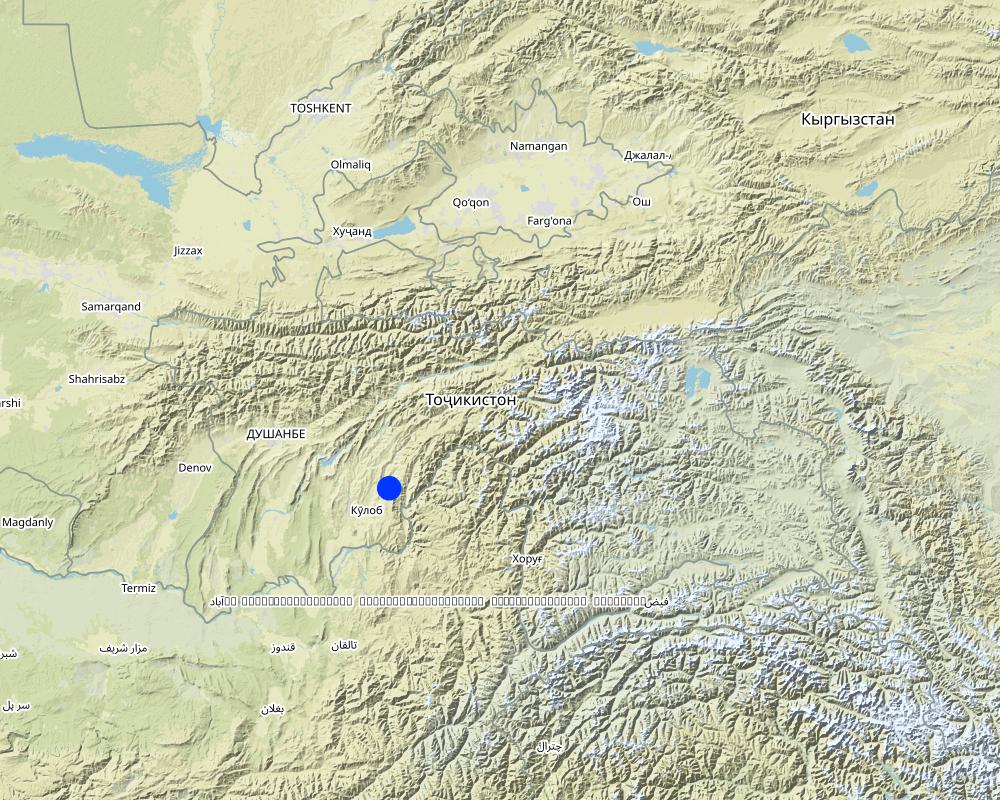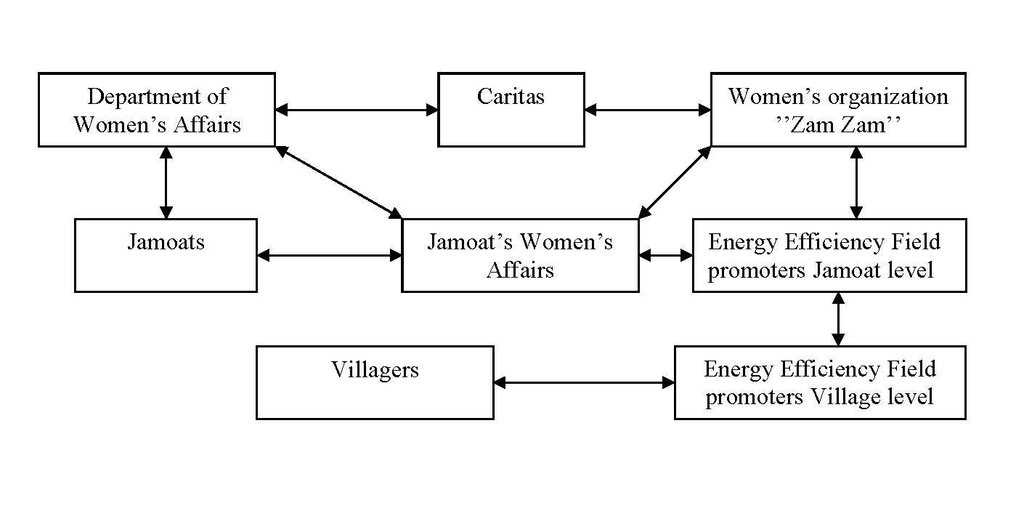Implementation through the government's Women's Affair Officers. [Tajiquistão]
- Criação:
- Atualização:
- Compilador/a: Sa'dy Odinashoev
- Editor: –
- Revisores: David Streiff, Alexandra Gavilano, Joana Eichenberger
approaches_2449 - Tajiquistão
Veja as seções
Expandir tudo Recolher tudo1. Informação geral
1.2 Detalhes do contato das pessoas capacitadas e instituições envolvidas na avaliação e documentação da abordagem
Especialista em GST:
Nome do projeto que facilitou a documentação/avaliação da Abordagem (se relevante)
Pilot Program for Climate Resilience, Tajikistan (WB / PPCR)1.3 Condições em relação ao uso da informação documentada através de WOCAT
Quando os dados foram compilados (no campo)?
06/07/2009
O compilador e a(s) pessoa(s) capacitada(s) aceitam as condições relativas ao uso de dados documentados através do WOCAT:
Sim
2. Descrição da abordagem de GST
2.1 Descrição curta da abordagem
The use of the government appointed District Womens Affair Officer to mobilise women throughout the community to implement technologies.
2.2 Descrição detalhada da abordagem
Descrição detalhada da abordagem:
Aims / objectives: The aim of the approach was to empower women through support from the government’s Women's Affairs Officer (WAO), to implement low cost energy efficient technologies within individual households. Women being the primary users of energy within the household, can become the main agents for change in applying more efficient methods to the use of natural resources to meet their cooking, heating and energy needs. Therefore, reducing fuel costs, and dependence upon local natural resources. The district local government employs a WAO, who is the government representative for women’s issues in the district. Once the WAO became supportive of the idea, she was able to engage the Women’s Affairs Officers at the Jamoat level.
Methods: This approach is fundamentally a training pyramid approach. An expert conducted a series of training sessions to interested women on the details of the technology. The training involves demonstrations of the technology, it's benefits, information on how to purchase or make the material required, and how to implement the technology. The first session is a ‘Training of Trainers’. The participants are then provided with training materials, and are invited to replicate the training in their own community. The process is continuously repeated, subsequently broadening the target audience. Zamzam, the local women’s association of the district helped suggest potential community candidates for trainers, and provided practical training sessions on energy efficiency measures through the TOT.
Stages of implementation: The implementation of the project started with an inception meeting with the District Women’s Affairs Officer to sell the idea, and to gain the local government’s support. Once she was supportive of the idea, a district level meeting was held with all the Women’s Affairs Officers at the local level (i.e. Jamoat) and two women representatives from each Jamoat. At this meeting the ladies were introduced to the technology i.e. cooking stove modification and heat exchangers. The meeting further discussed on how each jamoat would receive training, and what training materials were to be distributed to the communities. The meeting enabled issues with the technology, logistics, monitoring and overall set up of the approach to be discussed. Afterwards an expert trained a group of women from each Jamoat on the technology and provided them with materials so that the training could be repeated within their own communities.
Role of stakeholders: This is a women's led approach, the Women’s' representative within the government, who are also Women’s association members, were responsible for organisation of the trainers, logistics and government documentation support. With support from Zamzam, the active women in the community were selected as trainers to receive training from the experts and provide subsequent outreach training to their communities.
2.3 Fotos da abordagem
2.5 País/região/locais onde a abordagem foi aplicada
País:
Tajiquistão
Região/Estado/Província:
Khatlon
Especificação adicional de localização:
Muminabad
Map
×2.6 Datas de início e término da abordagem
Indique o ano de início:
2009
Ano de término (caso a abordagem não seja mais aplicada):
2010
2.7 Tipo de abordagem
- governmental
2.8 Principais metas/objetivos da abordagem
The Approach focused mainly on SLM with other activities (Energy Efficiency)
The aim of the approach was to mobilise the women within the community through the use of the government appointed District Women's Affairs Officer. Once the government appointee was engaged in the promotion of the technology, she was able to use her position to mobilise the Women's Representative at the local government level (Jamoat), and subsequently women's representatives within each village level. The approach exploits the existing government's women's network to empower women to implement technologies, whilst also gaining government support and assistance.
The SLM Approach addressed the following problems: The average household in the Muminabad area uses several tonnes of tapak (dung and straw mix) and firewood each year for cooking, baking and heating. This puts excessive strain on the local natural resources, and significantly reduces the amount of organic fertiliser used in land management, as well as the removal of tree and shrubs that stabilise the land and help prevent erosion from wind, surface water run off and livestock grazing.
2.9 Condição que propiciam ou inibem a implementação de tecnologia/tecnologias aplicada(s) segundo a abordagem
Disponibilidade/acesso a recursos e serviços financeiros
- Inibitivo
At the beginning women did not know that modification of the cookingstoves were not expensive, and were initially not interested in learning about the adaptation.
Treatment through the SLM Approach: Demonstration of the technolgy and explanation of the costs.
Quadro institucional
- Inibitivo
The women have been using the same style of outdoor cooking stove for many years and did not consider or were open to changing the design.
Treatment through the SLM Approach: A group workshop created an open environment in which the women could think about their energy use, their cooking equipment and discuss potential changes.
3. Participação e papel das partes interessadas envolvidas
3.1 Partes interessadas envolvidas na abordagem e seus papéis
- Usuários de terra/comunidades locais
Women's group to conduct training on the technology and women in households
The active women in the village were selected to disseminate information
- Especialistas em GST/ consultor agrícola
To organise the training materials.
- Governo local
District and local government women's affairs officers.
The entire approach was developed to engage women, as they would be the ones that would benefit most from the technology.
- Organização internacional
Provided the funding and monitoring.
3.2 Envolvimento do usuários de terra/comunidades locais nas diferentes fases da abordagem
| Envolvimento do usuários de terra/comunidades locais | Especifique quem estava envolvido e descreva as atividades | |
|---|---|---|
| Iniciação/motivação | Automobilização | It was members of the local community that thought of the idea and approached the governments Women's Affair Officer. |
| Planejamento | Participativo | The local stakeholders organised a initial meeting to plan the implementation of the approach. |
| Implementação | Automobilização | Implementation was entirely through the local community, including government representatives at district and local level. |
| Monitoramento/avaliação | Apoio externo | This was undertaken by the donor and at the district level. |
| Research | Nenhum | None |
3.3 Fluxograma (se disponível)
Descrição:
An organisational chart showing how all the organisations worked together on the project.
Autor:
Odinashoev, Sa (Muminabad, Tajikistan)
3.4 Decisão sobre a seleção de tecnologia/tecnologias de GST
Especifique quem decidiu sobre a seleção de tecnologia/tecnologias a serem implementadas:
- Principalmente usuários da terra, apoiados por especialistas em GST
Explique:
The idea for the approach was developed by representatives of the local community, who were interested in implementing a technology that would improve the lives of women in the community.
Decisions on the method of implementing the SLM Technology were made by mainly by SLM specialists with consultation of land users. The technology of improved cooking stoves was already developed, tried and tested, the approach orginated from already knowing which technology to implement.
4. Suporte técnico, reforço das capacidades e gestão do conhecimento
4.1 Reforço das capacidades/formação
Foi oferecida formação aos usuários da terra/outras partes interessadas?
Sim
Especifique quem foi capacitado:
- Equipe de campo/consultores
- Women's groups
Caso seja relevante, especifique gênero, idade, status, etnia, etc.
The project personnel provided the initial training to the women, who in turn then trained within their own communities.
Tipo de formação:
- Agricultor para agricultor
- Áreas de demonstração
Tipo de formação:
- Training was held within the communties.
Assuntos abordados:
The training was on energy efficiency measures, and how to reduce the amount of organic material used as fuel.
4.2 Serviço de consultoria
Os usuários de terra têm acesso a um serviço de consultoria?
Não
4.3 Fortalecimento da instituição (desenvolvimento organizacional)
As instituições foram fortalecidas ou estabelecidas através da abordagem?
- Sim, significativamente
Especifique a que nível (níveis) as instituições foram fortalecidas ou estabelecidas:
- Local
Especifique o tipo de apoio:
- Reforço das capacidades/formação
Dê mais detalhes:
Local NGO Zam Zam, a women's network, was used to conduct the training.
4.4 Monitoramento e avaliação
Monitoramento e avaliação são partes da abordagem?
Sim
Comentários:
no. of land users involved aspects were regular monitored by project staff through observations; indicators: The quality of the training was observed.
no. of land users involved aspects were regular monitored by project staff through measurements; indicators: The number of women that received training was monitored.
There were no changes in the Approach as a result of monitoring and evaluation: None
There were no changes in the Technology as a result of monitoring and evaluation: None
4.5 Pesquisa
A pesquisa foi parte da abordagem?
Sim
5. Financiamento e apoio material externo
5.1 Orçamento anual para o componente de GST da abordagem
Caso o orçamento exato seja desconhecido, indique a faixa:
- 2.000-10.000
Comentários (p. ex. principais fontes de recursos/principais doadores):
Approach costs were met by the following donors: government (Government covered costs related to workshop for women's groups): 10.0%; international non-government (Covered the expenses such as travel and materials.): 90.0%
5.2 Apoio financeiro/material concedido aos usuários da terra
Os usuários da terra receberam apoio financeiro/material para a implementação de tecnologia/tecnologias?
Sim
Caso afirmativo, especifique tipo(s) de apoio, condições e fornecedor(es):
The state provided personnel support and facilities for meetings
5.3 Subsídios para entradas específicas (incluindo mão-de-obra)
- Equipamento
| Especifique quais entradas foram subsidiadas | Em que medida | Especifique os subsídios |
|---|---|---|
| metal door | Parcialmente financiado | |
- Outro
| Outros (especifique) | Em que medida | Especifique os subsídios |
|---|---|---|
| transport cost | Totalmente financiado | fuel, taxi |
Se a mão-de-obra pelos usuários da terra foi uma entrada substancial, isso foi:
- Voluntário
Comentários:
It is a relatively low cost approach that required traing materials, transport and demonstration equipment. The main part of the finance was required for the implementation stage of the technology, whereby half the costs were met by the land user and the rest by the donor.
5.4 Crédito
Foi concedido crédito segundo a abordagem para atividades de GST?
Não
6. Análise de impactos e declarações finais
6.1 Impactos da abordagem
A abordagem auxiliou os usuários da terra a implementar e manter as tecnologias de GST?
- Não
- Sim, pouco
- Sim, moderadamente
- Sim, significativamente
The approach helped raise awareness on how to reduce the amount of organic material needed to meet the domestic fuel needs, and the saved material could be used as organic fertiliser.
A abordagem concedeu autonomia aos grupos social e economicamente desfavorecidos?
- Não
- Sim, pouco
- Sim, moderadamente
- Sim, significativamente
It improved the cooking conditions of women, and reduced their workload in the collation of natural resources to meet the household fuel needs.
A abordagem melhorou as questões de posse de terra/diretos do usuário que inibiam a implementação das tecnologias de GST?
- Não
- Sim, pouco
- Sim, moderadamente
- Sim, significativamente
Did other land users / projects adopt the Approach?
- Não
- Sim, pouco
- Sim, moderadamente
- Sim, significativamente
Did the Approach lead to improved livelihoods / human well-being?
- Não
- Sim, pouco
- Sim, moderadamente
- Sim, significativamente
The associated technology helped reduce smoke in the kitchens and a reduction in the amount of time, resources and finance that was spent on household fuel.
Did the Approach help to alleviate poverty?
- Não
- Sim, pouco
- Sim, moderadamente
- Sim, significativamente
It helped reduce the amount of money spent on fuel and helped preserve natural resources.
6.2 Principal motivação dos usuários da terra para implementar a GST
- Lucro (lucrabilidade) aumentado, melhora da relação custo-benefício
Reduce money spent on fuel.
- Carga de trabalho reduzida
The associated technologies helped reduce workload.
- normas e regulamentos (multas)/aplicação
The endorsement by the district government helped influence adoption rates.
- Prestígio, pressão social/coesão social
The approach tried to include as many women as possible, the social pressure to participate grew.
- Afiliação a movimento/projeto/grupo/rede
To a degree there was empowerment of women.
- Consciência ambiental
Reducing the amount of smoke in the outdoor kitchen
- well-being and livelihoods improvement
Hopefully improvement in health from less smoke, less money spent on fuel and less workload.
6.3 Atividades de sustentabilidade de abordagem
Os usuários da terra podem manter o que foi implementado através da abordagem (sem apoio externo)?
- Sim
Caso afirmativo, descreva como:
The approach needs minimal finance to continue.
6.4 Pontos fortes/vantagens da abordagem
| Pontos fortes/vantagens/oportunidades na visão do usuário da terra |
|---|
| It is easy to train a group of women, it is much harder to train men. (How to sustain/ enhance this strength: The women could benefit from further instructions on how to train. ) |
| Pontos fortes/vantagens/oportunidades na visão do compilador ou de outra pessoa capacitada |
|---|
| The approach incorporates government support. (How to sustain/ enhance this strength: It may mean that further approaches and endorsements will have government support and generate further interest from the authorites.) |
| The approach is easy to replicate and has the potential to reach many beneficaries. (How to sustain/ enhance this strength: It could be replicated in other areas and regions. ) |
| The approach is designed specifically for the target beneficaries. (How to sustain/ enhance this strength: Other technologies that specifically benefit women could adopt this approach.) |
6.5 Pontos fracos, desvantagens da tecnologia e formas de superá-los
| Pontos fracos/vantagens/riscos na visão do compilador ou de outra pessoa capacitada | Como eles podem ser superados? |
|---|---|
| Because the approach is specifically for women it could limit the uptake by men. | Maybe subsequent training sessions could be held for men. |
| Some of the poorer households were not in a position to contribute to buying the materials or to implement the technology. This, therefore, exclused the poorest in the community. | Other memebers of the community could provide support. It should be noted that any contribution no matter how small puts a financial worth on the technology. |
7. Referências e links
7.1 Métodos/fontes de informação
- visitas de campo, pesquisas de campo
- entrevistas com usuários de terras
Links e módulos
Expandir tudo Recolher tudoLinks
Não há links
Módulos
Não há módulos


